Introduction to Ai in Embedded Systems
AI systems are always known to be powerful systems, which require bulky high performance computing systems to function. For these systems to function efficiently in smaller devices like desktops or mobile phones, they need a strong and appropriate internet connection.The integration of AI into Embedded systems is creating a huge impact on various industries as these systems will be capable of handling huge workloads without any connectivity issues. Embedded AI has several key trends that emerge to be very influential.
The new generation of Embedded AI systems has emerged from the development of machine learning and deep learning algorithms from the early 2000s, and this is the secret behind all the smart gadgets that make our day to day life easier. Image recognition, natural language processing, and speech recognition are some of the complicated AI tasks which are performed by these systems.
Top 5 AI Trends are as follows:
1.NVIDIA's dominance
An American multinational corporation, NVIDIA is a technology business which provides various resources to multiple markets and industries. They create and produce system on a chip units (SoCs) which are used by the mobile computing and automotive markets, graphics processing units (GPUs), and application programming interfaces (APIs) for data science and high-performance computing.
NVIDIA then discovered that GPUs could also be used for parallel processing other than graphics. After this, the company started to make advancements in Artificial Intelligence computing, this resulted in creating CUDA and allowing GPUs to do sophisticated computational tasks like deep learning and artificial intelligence.In 2007 NVIDIA made the first move into high-performance computing with releasing the Tesla GPU.
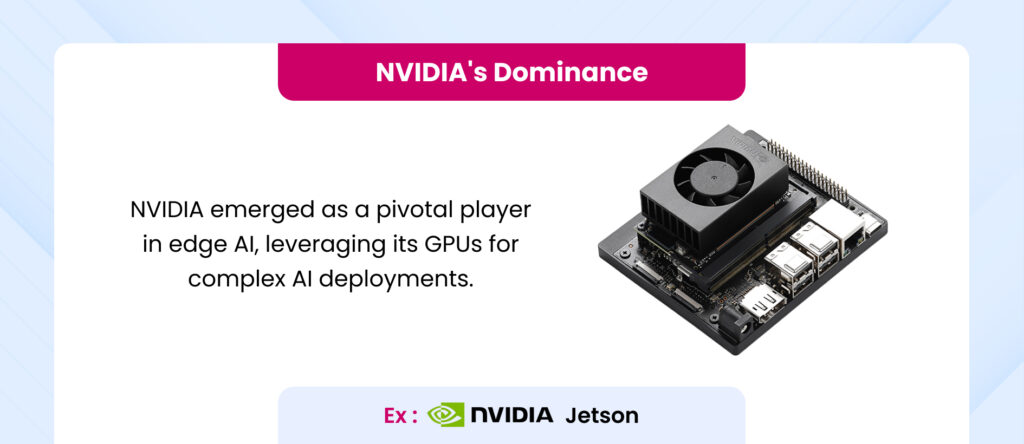
Key factors contributing to NVIDIA's leadership in this space
Powerful GPU Architecture
AI-Specific Hardware
Comprehensive Software Ecosystem
AI Research and Development
Strategic Acquisitions and Investments
Dominance in AI Training and Inference
Market Leadership in Autonomous Vehicles
Strong Developer Community
Future-Oriented Innovations
NVIDIA has not only excelled in strategic innovations but has also included strategic investments and has a strong ecosystem of Hardware and software which has made NVIDIA to dominate in the AI and Embedded systems market
2.Developer platforms
Developers can easily build, deploy, and manage applications with the help of the resources provided by Developer Platforms. They are nothing but tools, environments, and ecosystems that can range from cloud services to code repositories. Each one of these tools works for specific needs in the development process.
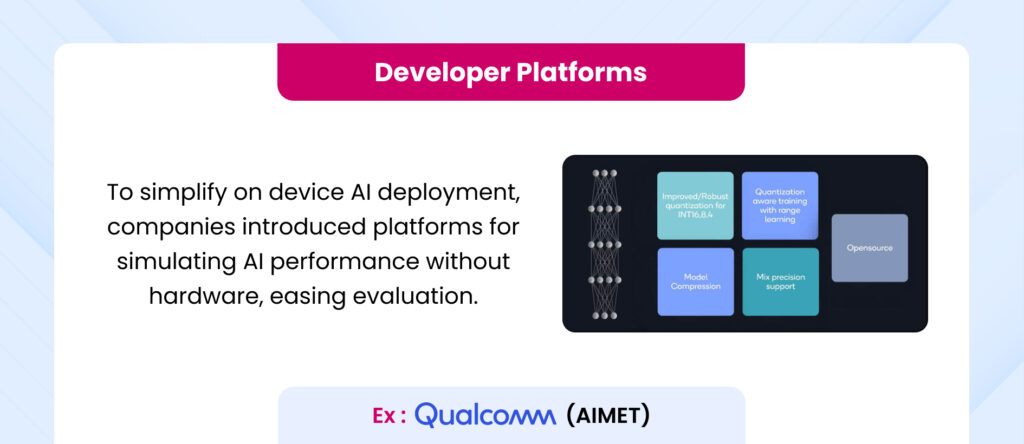
These platforms play a crucial role in AI simulation without the need for specialized hardware by providing various tools and resources that allow developers to build, test, and deploy AI models in a more accessible and efficient manner. Here are some ways through which developer platforms achieve this:
Developer platforms also provide various tools and resources, which plays an essential role in AI stimulation. These platforms allow us to proceed with AI stimulation without the need for any specialized Hardware, which makes the process of building, testing, and deploying AI more accessible and efficient.Here are some ways through which developer platforms achieve this:
Cloud-Based AI Services:With platforms like AWS, Google Cloud, and Microsoft Azure providing us with cloud-based infrastructure, it is possible to eliminate the need for physical hardware ownership. Through these services developers can easily access powerful GPUs, TPUs, and other specialized hardware that are on demand.
Pre-Trained Models like IBM Watson, Google AI, and Azure AI offer pre-trained models that can be fine-tuned for specific tasks. This approach significantly reduces the need for extensive computational resources and hardware.
APIs Platforms Developers can integrate AI functionalities like natural language processing, computer vision, or speech recognition into their applications through APIs without needing to build or train models from scratch.
Virtual environments are offered by some platforms that can simulate hardware conditions, allowing developers to test and validate their AI models under different conditions without needing the actual hardware.
Digital Twins are virtual replicas of physical systems. Developer platforms can use digital twins to simulate real-world scenarios, enabling AI model testing and development in a controlled virtual environment.
Developer platforms provide the infrastructure, tools, and community support needed to accelerate AI development, from initial prototyping to large-scale deployment.
For Example, Qualcomm’s AI Model Efficiency Toolkit (AIMET) eases AI deployment by optimizing machine learning models to be more efficient, which directly reduces hardware requirements and simplifies the evaluation process.
3.NPU integration
A Neural Processing Unit is a hardware accelerator that enables faster data processing, reduced latency, and lower power consumption. AI applications are becoming more sophisticated and computationally demanding and hence importance of NPU integration is increasing day by day. They are mainly designed to optimize the performance of AI and machine learning tasks.
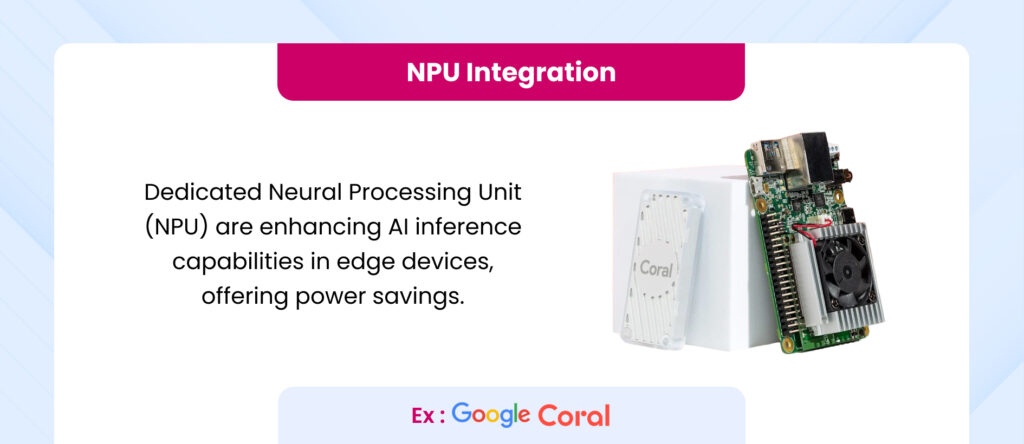
The traditional processors like CPUs (Central Processing Units) and GPUs (Graphics Processing Units) used to handle a wide range of computing tasks whereas NPUswhivh are specialized micro processors are optimized for performing the mathematical operations required for neural networks, such as matrix multiplications and convolutions. These NPUs mainly accelerate machine learning tasks, particularly those related to deep learning and artificial intelligence (AI).
NPUs contribute to the development of smaller AI systems which can easily be embedded into multiple devices. This is possible because they are specifically designed to handle neural network computations efficiently. NPUs are majorly used in many devices from smartphones to wearable tech and IoT sensors as they provide a more compact and specialized hardware when compared to other processors like CPUs and GPUs. They reduce physical space required and achieve this by being part of custom System-on-chip(SoC) designs in which multiple components (CPU, GPU, NPU, etc.) are integrated into a single chip.
Some applications require quick and efficient AI processing in order to provide customer satisfaction and NPUs play a significant role in these applications as they offer real-time AI processing on portable devices. This is done by the NPUs without draining the battery and hence is used in features like augmented reality, voice recognition, and on-device facial recognition. NPUs being power efficient also contributes to the longevity of battery-powered devices
4.Cellular IoT decision-making
IoT devices can be managed and connected by using Cellular IoT through cellular networks, which gives us widespread coverage, reliability, and security of cellular networks and also supports real-time decision-making in AI systems. Integrating AI with cellular IoT, we can allow the devices to process information locally or on the cloud which makes better decisions from collected information.
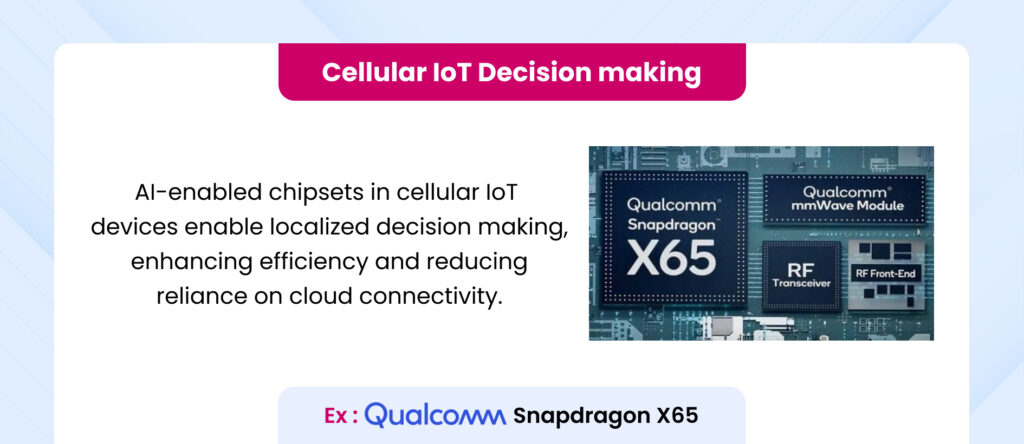
AI-enabled cellular IoT modules include specialized chipsets for AI acceleration, enabling more dynamic and responsive applications. Most of the applications of cellular IoT modules will need timely decision-making, and hence, this technology is majorly applied. Efficient operation of devices is achieved by the combination of AI with cellular IoT; these modules are applied in smart cities, industrial automation, and healthcare monitoring. These modules can maintain a continuous flow of the data even in remote and mobile environments without any disruptions.
While still in its early stages, AI and cellular IoT convergence holds immense potential to revolutionize industries. Integrating AI directly into IoT modules means AI inference can occur at the edge, allowing for rapid and intelligent decision-making at the edge. This reduces data transmission over cellular networks, saves bandwidth and costs, and facilitates immediate, autonomous decision-making for time-sensitive applications. Further, embedding AI chipsets within connectivity modules can save space and streamline the form factor of IoT devices. In all, these modules are evolving from mere data communication enablers to intelligent edge nodes capable of handling certain workloads independently
5.Tiny AI/ML
“Tiny AI” or “TinyML” refers to the development of machine learning models that are small enough to run on devices with very limited computational resources, such as micro controllers, sensors, and other edge devices. This field focuses on optimizing AI algorithms to work efficiently on hardware with minimal memory, processing power, and energy consumption.
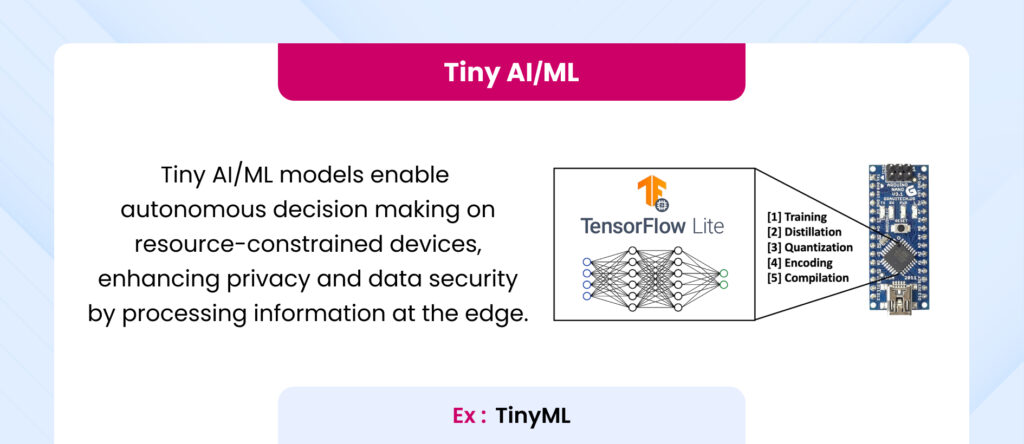
Model Compression: This involves Training a smaller model to mimic the behavior of a larger, more complex model. This can be done by Reducing the precision of the numbers used in model computations (e.g., using 8-bit integers instead of 32-bit floating-point numbers) to reduce model size and computational demands. We can also remove less important neurons or connections in a neural network to make the model smaller and faster.
Efficient Architectures:The architecture of Tiny AI/ML is designed to balance efficiency with performance, enabling AI models to run on devices with limited computational resources, such as micro controllers or embedded systems. Use of Mobilenets A family of neural network architectures designed for efficient execution on mobile and embedded devices. SqueezeNet is also a smaller neural network architecture that achieves similar accuracy to larger models but with fewer parameters.
Edge AI: This refers to the deployment and execution of AI models on edge devices, such as micro controllers, sensors, smartphones, and other embedded systems with limited computational resources. This approach allows AI processing to occur directly on the device rather than relying on cloud-based servers. The integration of Tiny AI/ML with Edge AI offers significant advantages in terms of latency, privacy, bandwidth, and energy efficiency.
Conclusion
The evolution of AI in embedded systems is shaping a future where devices are more intelligent, responsive, and efficient. These trends highlight the growing influence of AI in embedded systems, where the need for real-time, on-device processing is paramount. As hardware capabilities continue to advance and AI models become more efficient, the integration of AI into embedded systems will likely accelerate, driving further innovation and expanding the range of possible applications. Together, these trends are not only transforming how embedded systems operate but also opening new possibilities for innovation in consumer electronics, industrial automation, healthcare, and beyond.
| Serial No. | Related Blogs | Links |
|---|---|---|
| 1. | The Future Scope of Embedded Systems : Trends and Predictions | Click Here |
| 2. | Why is C The Most Preferred Language for Embedded Systems? | Click Here |
| 3. | Introduction to Device Drivers in Embedded Systems | Click Here |
People Also Ask (PAA)
In the future, we can expect AI in embedded systems to advance through more powerful and energy-efficient processors, enabling complex AI tasks on even smaller devices. The integration of AI with 5G and IoT will create smarter, more interconnected environments, and AI models will become more adaptive, allowing for continuous learning and improved performance in diverse conditions.
AI enhances IoT and smart devices by enabling them to process data locally, make real-time decisions, and adapt to user behaviors. It allows these devices to perform tasks autonomously, predict maintenance needs, optimize energy use, and provide personalized experiences, all while reducing the need for constant cloud connectivity. This integration makes IoT systems smarter, more responsive, and efficient.
Industries most impacted by AI trends in embedded systems include consumer electronics, automotive (through autonomous vehicles and advanced driver-assistance systems), healthcare (with smart medical devices and diagnostics), industrial automation (for predictive maintenance and process optimization), and smart cities (enhancing infrastructure and public services). These sectors are leveraging AI in embedded systems to improve efficiency, safety, and user experiences.
